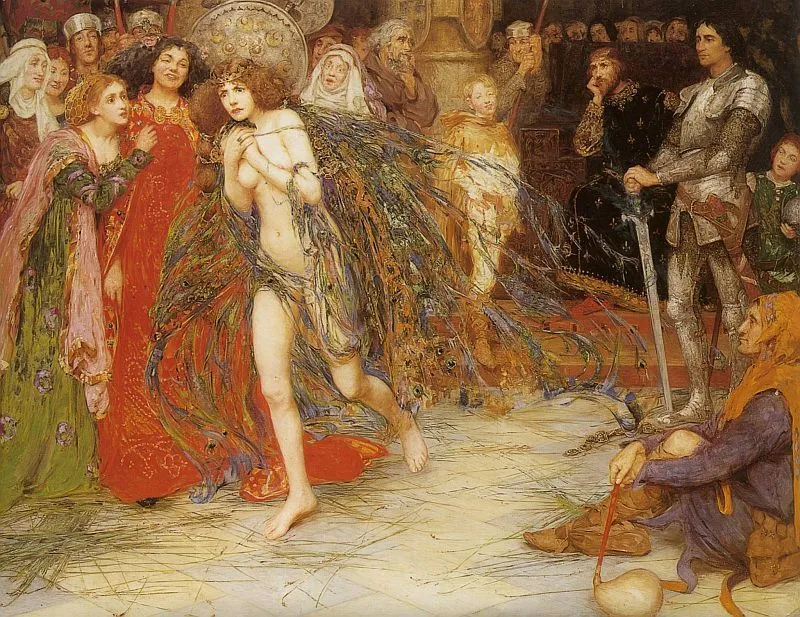Hew Locke stands amid The Procession in the Duveen Galleries. Photograph: Guy Bell/Alamy (from The Guardian)
Like a New Orleans funeral without the sound, Hew Locke’s Procession
through the Duveen Galleries of Tate Britain is part carnival, part wake; joyous in spirit, sorrowful in memory. It is jaw-dropping in its scale and conception: well over a hundred life-size figures, clothed and accessorised, each an individual.
The colour and pageantry alone is enough to make you take a slow procession of your own along the
length and back. Enough to pause and go again. There is an element of frustration that you cannot engage
more fully, walk amongst them and literally join the parade. The Tate's line on the floor is a barrier of sorts, but not the main one. The figures themselves, alienating behind their masks and head-dresses, united and self-contained, do not seem to want or need you to join them. The whole of humanity is represented, but there is no place for you. The viewer becomes the outsider.There are men, women, children, horses; old and young; pregnant; maimed. Men about town off to a party, protest marchers, carnival queens and shamans; regal parade, refugee train, Day of the Dead; bejewelled conspicuous consumption, military uniforms, flower-wearing, flag-waving, drum-beating. All of life is here. Yet every time you pick up a reference it slips through your fingers, defying labels, resisting order and control. Stragglers at the back seem dusty and weary: water stains on their clothing suggesting perhaps the perils of the climate emergency for a low lying nation like Guyana. At the head of the procession masked figures swathed in black fabric, flowing in apparent motion, carry aloft a pyramid of material topped by an imperious mask. More alien than human, it speaks of the emptiness and facelessness of power.
The more you look, the more the detail takes over. Imperial bonds printed on fabric, old master
paintings re-appropriated, dilapidated buildings, maps, graphics of slave ships, sugar plantations, flag colours, medallions, animal heads, death masks. Many are images which Locke has used before, themes which he has returned to many times. In themselves they are hardly subtle and the wall text here, with its discussion of the Tate's past, of sugar and slavery, has the same banal obviousness. It is a pity because the way the artist has used the trappings of Empire in the actual installation is clever, thoughtful, sometimes even humorous, adding to the layering, the cacophony, the power. This is not about the legacy of one man or the funding of one gallery, The Procession reflects on a global system of control and exploitation.
The more you look, too, the more the sheer craft involved becomes overwhelming. Yes, there are found objects and readymade clothes, but there are elaborately abstract shields and headdresses, characterful animal masks, hand printed fabrics, batiks, patchwork. Figures created from cardboard, papier mache, plaster, recycled plastic. Hundreds of hours of labour and love, planning, preparation. And choreography, because from every angle and on every level the figures interact in a beautiful, endlessly interesting static ballet.
During the Commonwealth Games in Birmingham, Hew Locke took over the city's
statue of Queen Victoria to create a temporary installation: Foreign Exchange. A boat was constructed round the 1951 bronze sculpture, itself a cast of the original marble work from 1901. Victoria was placed in a crate alongside five smaller versions of herself, all masked and wearing oversized medallions which depicted famous Imperial battles. Imperial propaganda ready for transportation to the colonies. The idea of Foreign Exchange was wonderful.
The reality left me cold. The hull, built around the statue on top of its plinth
seemed marooned and awkward, almost comic; the detailing of the sculptures' masks
and medals was lost. The ideas of medals, ships, and public sculpture are long standing themes in Locke's work, and the artist has been planning such an
intervention for years. But I am not sure the reality lived up to the concept.
Ideas, however strongly felt, are not enough to make a great artwork. The success of The Procession derives from ideas that are fully developed into a crafted, considered, coherent whole, all the more striking because it appears spontaneous and anarchic, uncontrolled and uncontrollable. In the end that is what makes The Procession such an emotive and enthralling experience: we desperately want to join the parade but as the figures make their way Pied Piper-like through the Tate and, one imagines, out, down the steps beyond its great Neoclassical portico, we are left behind.









